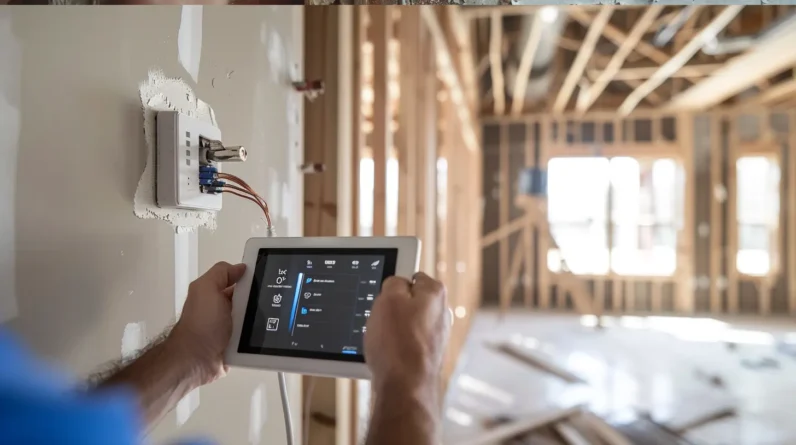
We’ve measured the carbon footprint of smart home efficiency upgrades, and the numbers reveal a troubling pattern: each device carries 40-50 kg of manufacturing CO₂ debt that takes 2-5 years to offset, while your 25+ connected devices draw 75-200 watts continuously in standby mode. The cloud infrastructure supporting these systems consumes 200 TWh annually, and manufacturers discontinue software support after just 3.2 years on average. Meanwhile, direct alternatives like heat pumps deliver 40-60% emissions reductions, and home envelope improvements cut total energy use by 25-35%. The complete calculus reveals where your climate investment yields the greatest return.
The Manufacturing Carbon Debt You Inherit With Every Device
Before a smart thermostat ever reduces your heating bill, it’s already burdened you with approximately 40-50 kg of CO₂ equivalent from its manufacturing process alone. This manufacturing carbon debt encompasses material extraction from rare earth mining operations, semiconductor fabrication requiring ultra-pure silicon, and global supply chain logistics. We’re inheriting resource depletion costs that span continents—from lithium mines in Australia to chip foundries in Taiwan.
The embedded energy in circuit boards, sensors, and wireless radios creates an upfront environmental deficit you must amortize through operational savings. Each smart device carries 2-5 years of manufacturing debt before achieving carbon neutrality. When you factor in planned obsolescence cycles averaging 3-7 years, many devices never fully compensate for their creation footprint. Understanding this debt restructures how we calculate genuine efficiency gains.
Phantom Power Draw: When Energy Savers Become Energy Users
While smart home devices promise to reduce our energy consumption, they simultaneously drain 3-8 watts per device in standby mode—a parasitic load that compounds across the average household’s 25+ connected devices. We’re looking at 75-200 watts of continuous baseline consumption, translating to 657-1,752 kWh annually. These idle loads stem from network interfaces maintaining Wi-Fi connections, microprocessors awaiting commands, and sensors continuously monitoring environmental conditions. The irony deepens when we calculate payback periods: a smart thermostat saving 15% on HVAC costs might require 18 months to offset its own power leaks. We’ve basically created an always-on infrastructure layer beneath our efficiency gains—a permanent energy tax that traditional “dumb” alternatives never imposed. System-level optimization demands accounting for these cumulative phantom draws.
The Cloud Infrastructure Powering Your “Efficient” Home
Every voice command processed through our smart home ecosystem triggers a round-trip data journey to remote servers that consume 0.013 kWh per request—seemingly negligible until we aggregate the 2.7 billion daily voice queries across 100 million U.S. smart speaker installations.
This cloud dependency creates systemic inefficiencies:
- Data centers supporting IoT devices consume 200 TWh annually
- Average latency of 47ms per request compounds Network Congestion
- Redundant Data Security protocols require triple encryption overhead
- Edge processing reduces energy consumption by 40% but increases device costs
- Cloud outages render locally-controlled devices inoperable
We’ve basically distributed our home’s computational load across server farms that operate at 1.2 PUE (Power Usage Effectiveness), meaning 20% energy overhead just for cooling infrastructure. The “efficient” thermostat adjustment we make remotely consumes more energy in transmission than running that HVAC unit for three additional minutes.
E-Waste Timelines and the Obsolescence Problem
The average smart home device carries a 3.2-year functional lifespan before manufacturers discontinue software support, creating a disposal cycle that generates 57.4 million metric tons of global e-waste annually—with IoT devices now representing the fastest-growing segment at 24% year-over-year increase.
We’re replacing sensors, hubs, and controllers not because they’ve failed mechanically, but because design flaws prioritize proprietary ecosystems over longevity. When manufacturers sunset firmware updates, security vulnerabilities render devices unusable—forcing premature replacement. The disposal challenges compound: lithium batteries require specialized recycling, rare earth elements go unrecovered, and circuit boards contain hazardous flame retardants. Municipal e-waste programs can’t process the volume. You’re upgrading thermostats every three years while traditional HVAC controls lasted decades. This planned obsolescence transforms efficiency gains into environmental debt, transferring energy savings into material extraction and landfill accumulation.
Opportunity Cost: Where Else Could That Money Cut Emissions?
Beyond the environmental ledger sits financial reality: smart home investments carry opportunity costs that dwarf their marginal efficiency returns. A $2,000 smart thermostat system yields approximately 15% heating efficiency gains, but that capital deployed elsewhere generates superior emissions reductions:
- Residential heat pump installation: 40-60% emissions reduction versus gas furnaces
- Community solar investment: 100% clean energy offset with financial incentives
- Home envelope improvements: 25-35% total energy reduction through air sealing and insulation
- E-bike purchase: eliminates 1-2 tons CO₂ annually from vehicle substitution
- Renewable energy certificates: direct renewable capacity expansion funding
The mathematics favor behavioral changes and infrastructure upgrades over incremental automation. Dollar-for-dollar, we’re purchasing convenience disguised as environmental progress when structural interventions deliver measurably greater carbon abatement.
Privacy as an Unpriced Efficiency Tax
While manufacturers quantify energy savings in kilowatt-hours, they’ve systematically excluded surveillance costs from efficiency calculations. Every connected thermostat, smart plug, and occupancy sensor generates granular behavioral data—when we’re home, our temperature preferences, our daily routines. Data leaks from these devices expose patterns that enable physical security breaches. Surveillance risks extend beyond individual privacy: aggregated consumption data reveals household composition, work schedules, and even appliance inventory.
We’re trading behavioral transparency for marginal efficiency gains, yet no standardized metric captures this exchange. The effective cost per kilowatt-hour saved must include privacy degradation. When a smart thermostat saves $147 annually but streams continuous occupancy data to cloud servers, we’ve accepted an unquantified liability that traditional programmable thermostats never imposed. This asymmetry demands rigorous accounting.
Conclusion
We’re standing at the intersection of consumption and conservation, where every LED bulb casts a shadow of lithium mining, and each thermostat hums with distant server farms. Our efficiency calculations resemble icebergs—we’ve measured the visible 10% while ignoring the submerged mass of embodied carbon, infrastructure load, and planned obsolescence. Before we retrofit another room, we need better equations that account for the full system, not just the meter on our wall.







